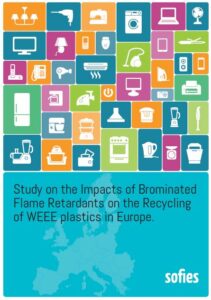The report, undertaken by consultancy SOFIES, uniquely addresses misperceptions regarding the impact of Brominated Flame Retardants (BFRs) on WEEE plastics recycling and presents the successes and overarching challenges in making WEEE plastic streams more circular.
Electronic and electrical equipment uses plastics to make products lighter, more innovative, and cost effective. Plastic components are inherently combustible and need to be protected from ignition. Brominated Flame Retardants are often used in plastics to meet fire safety standards and protect consumers from accidental fires. Brominated Flame Retardants are the most efficient group of chemistries as they can be used across many plastics, offering a high degree of performance, and choices for design.
Key findings
- Approximately 2.6 million tons of WEEE plastics are generated annually in Europe; Plastic containing BFRs represent about 9% of this total.
- Around half of all WEEE plastics generated in Europe do not enter official WEEE collection channels, ending up in the waste bin, processed at substandard recycling facilities, or exported outside Europe.
- On average, 55% of WEEE plastics entering specialized WEEE plastic recycling facilities are effectively recycled, i.e. turned into PCR (Post-Consumer Recycled) plastics that can be used in the manufacture of new plastics products.
- Restricted BFRs (e.g. Octa-BDE and Deca-BDE) only represent a small and rapidly declining fraction of all BFRs found in WEEE plastic streams reflecting the restriction on the use of these substances for more than a decade (2003 for Octa-BDE, 2008 for Deca-BDE).
- The presence of BFRs in WEEE plastics does not reduce recycling yields more than other FRs as FR-containing plastics, as well as plastics containing other additives in significant loads (e.g. fillers), are sorted out during the conventional density-based recycling process.
Welcoming the report and its findings, APPLiA, the voice for the home appliance industry in Europe, commented: “Ensuring consumer safety is the number one priority of the home appliances sector. Then, the level of circularity that we can achieve when recycling products is a matter of improving and working together with other actors in the value chain to make sure that we enable a higher degree of circularity, while keeping what to us is extremely important, which is consumer safety.”
EERA, the association of the Electronics Recyclers in Europe, also welcomed the report noting its findings confirm what the actual recycling practice experiences are in the EU. EERA added: “The WEEE recycling industry has learned perfectly well how to deal with brominated flame retardants. REACH, RoHS and POP Regulation compliant Post-Consumer Recycled plastics can be produced from the complex mix of WEEE plastics and these PCR plastics can be re-used in new appliances. The problems related to restricted legacy BFRs, as this study is clearly showing, is disappearing quickly”.
However, EERA cautioned that the progress achieved to date will not be helped by further reducing thresholds for restricted BFRs. “The WEEE Directive requires us to separate all BFRs whether restricted or not. We rely on screening the element bromine to achieve this cost-effectively. However, we are now screening out more useful plastics with non-restricted BFRs than legacy BFRs”, they noted.
Dr Kevin Bradley, Secretary General of the International Bromine Council, BSEF, highlighted: “this report clearly shows that restricted BFRs are a rapidly declining component of the total BFRs in WEEE plastics demonstrating the effectiveness of RoHS restrictions”, he noted. “Policy makers need to focus on the core issues here, namely the substantial volume of WEEE plastics which is leaking out of Europe and treated in a sub-standard way as well as looking for solutions to recycling more of the high additive fraction of WEEE plastics”, he added.
The report contains important recommendations for policymakers, electrical and electronic equipment producers and recyclers. With the European Commission working on a proposed “Circular Electronics Initiative”, these recommendations merit consideration and inclusion in this initiative.











